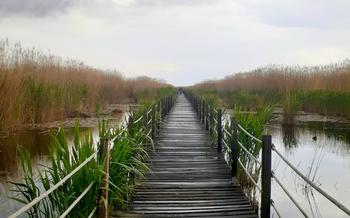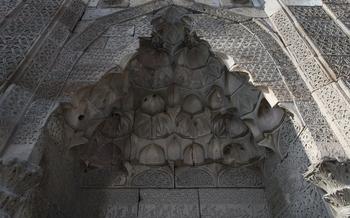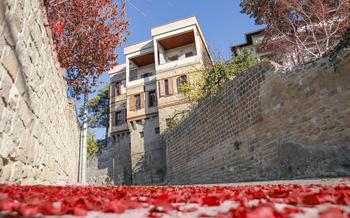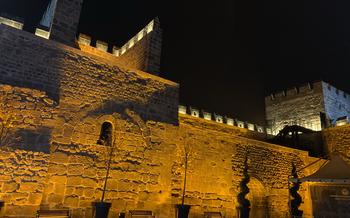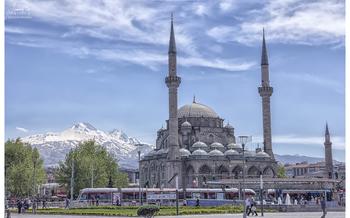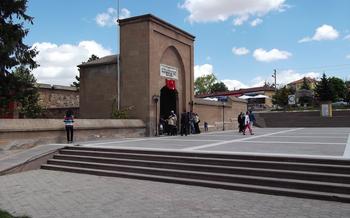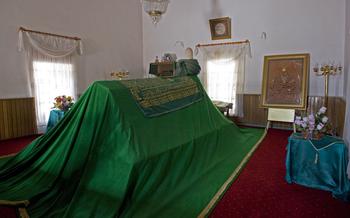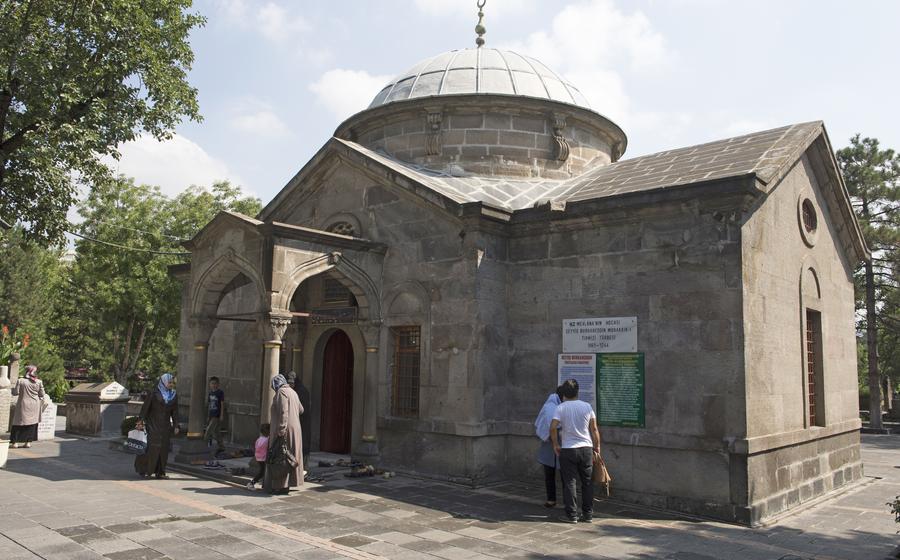
Seyyid Burhaneddin Mausoleum
- History of the Seyyid Burhaneddin Mausoleum
- Location and Accessibility
- Visiting Hours and Fees
- Exploring the Mausoleum
- The Dervish Lodge
- The Museum
- The Tombstone: A Symbol of Reverence
- Local Customs and Traditions
- Pilgrimage and Festivals
- Other Nearby Attractions:
- Unique Features:
- Best Time to Visit
- Photography Tips: Capturing the Essence of the Seyyid Burhaneddin Mausoleum
- Local Cuisine
- Tastes of Kayseri
- Culinary Delights Await
- A Culinary Adventure
- Insider Tip: Unveiling the Secret Chamber
History of the Seyyid Burhaneddin Mausoleum
The Seyyid Burhaneddin Mausoleum, the final resting place of an esteemed Sufi saint, Seyyid Burhaneddin, is a captivating historical monument that holds a significant place in the cultural and religious heritage of Kayseri, Turkey. In the 14th century, during the reign of the Seljuk Sultanate, the mausoleum was erected to honor the life and teachings of Seyyid Burhaneddin, a revered figure in the Sufi tradition.
Seyyid Burhaneddin, a prominent Sufi master and mystic, was widely revered for his piety, wisdom, and spiritual influence. His teachings emphasized the pursuit of inner peace, love, and harmony, leaving a profound impact on the local community. The construction of this mausoleum served as a testament to his legacy, attracting pilgrims and visitors from far and wide who sought blessings and spiritual guidance.
The architectural style of the mausoleum exudes a harmonious blend of Seljuk and Ottoman influences, incorporating elements from both periods. Its intricate stonework, graceful arches, and decorative motifs reflect the artistry and craftsmanship of the era, creating a visually striking monument that commands attention.
Location and Accessibility
The Seyyid Burhaneddin Mausoleum is situated in the heart of Kayseri, Turkey, approximately 3 kilometers from the city center. To reach the mausoleum, visitors can take public transportation or hire a taxi. Buses departing from the Kayseri Bus Terminal frequently stop near the mausoleum. Alternatively, the Kayseri Airport, located 15 kilometers from the city center, offers regular domestic and international flights. From the airport, visitors can take a taxi or rent a car to reach the mausoleum. Private guided tours are also available for those who prefer a comprehensive and personalized experience.
Visiting Hours and Fees
The Seyyid Burhaneddin Mausoleum is generally open to visitors from 8:00 AM to 6:00 PM every day of the week, including weekends. However, it is advisable to check the official website or contact the local authorities for any temporary changes or special closures.
Admission to the mausoleum is free of charge, allowing visitors to explore the site and its various components without any financial constraints. This open access policy encourages everyone to learn about the history, architecture, and spiritual significance of the mausoleum without any barriers.
The free admission policy is a testament to the commitment of preserving and sharing the rich cultural heritage of Turkey with both domestic and international visitors. It aligns with the nation's efforts to promote tourism and cultural exchange, fostering a deeper appreciation for the diverse historical and religious traditions that shape the country's identity.
Exploring the Mausoleum
The Seyyid Burhaneddin Mausoleum showcases a blend of Seljuk and Ottoman architectural styles, reflecting the rich history of Kayseri. As you step inside, intricate tilework, colorful patterns, and elegant calligraphy adorn the walls and ceilings, creating a visually stunning ambiance. The central focus of the mausoleum is the tomb of Seyyid Burhaneddin, which is enclosed within a finely crafted shrine. The shrine is embellished with intricate carvings and verses from the Quran, highlighting the saint's spiritual significance. Visitors can also admire the marble sarcophagus, adorned with intricate designs and inscriptions, which rests atop the tomb. The mausoleum also features a unique collection of artifacts and relics related to Seyyid Burhaneddin's life and teachings, providing visitors with a deeper understanding of his legacy.
The Dervish Lodge
The Seyyid Burhaneddin Mausoleum complex also encompasses a dervish lodge, a significant structure in the Sufi tradition. Dervish lodges served as gathering places for Sufi mystics and followers to engage in spiritual practices, ceremonies, and rituals. The lodge associated with the mausoleum holds historical and cultural importance as a testament to the Sufi way of life.
The dervish lodge features a unique architectural design that reflects its purpose and symbolism. It typically consists of a large central hall surrounded by smaller rooms or cells where dervishes resided and engaged in their spiritual practices. The lodge's interior often showcases intricate carvings, colorful tiles, and decorative elements that create a serene and contemplative atmosphere.
Visitors to the mausoleum can explore the dervish lodge and gain insights into the Sufi tradition. The lodge offers a glimpse into the daily lives of dervishes, their rituals, and their pursuit of spiritual enlightenment. It serves as a reminder of the rich cultural heritage and spiritual practices associated with Sufism in Turkey.
The Museum
The Seyyid Burhaneddin Mausoleum complex also houses a museum dedicated to the Sufi saint and his legacy. The museum showcases an array of artifacts and exhibits that provide insights into Seyyid Burhaneddin's life, teachings, and the Sufi tradition.
Visitors to the museum can explore a diverse collection of items, including personal belongings, manuscripts, and artwork related to Seyyid Burhaneddin. These artifacts offer a glimpse into the saint's personal life and his influence on the development of Sufism in the region.
A highlight of the museum is the display of Seyyid Burhaneddin's handwritten manuscripts. These manuscripts contain his teachings, spiritual insights, and philosophical reflections. They provide a valuable resource for scholars and researchers seeking to understand the Sufi tradition and its practices.
Another interesting exhibit in the museum showcases the tools and instruments used by Sufi mystics for their spiritual practices. These include prayer beads, meditation mats, and musical instruments such as the ney (reed flute) and the daf (frame drum). Visitors can gain a deeper appreciation for the rituals and practices of Sufism through these artifacts.
The museum at the Seyyid Burhaneddin Mausoleum offers a unique opportunity for visitors to delve into the life and teachings of a revered Sufi saint. It provides an immersive experience that enhances the understanding of Sufism and its profound impact on the cultural and spiritual heritage of Turkey.
The Tombstone: A Symbol of Reverence
The tombstone of Seyyid Burhaneddin holds a profound significance within the Islamic tradition. It serves as a tangible marker of the saint's final resting place and a symbol of his enduring legacy. The tombstone is adorned with intricate carvings and inscriptions that pay homage to the life and teachings of Seyyid Burhaneddin.
Calligraphy and Inscriptions:
The tombstone features exquisite calligraphy, showcasing verses from the Quran and expressions of devotion to the saint. These inscriptions are a testament to the deep reverence and admiration held for Seyyid Burhaneddin by his followers and the wider community.
Historical Significance:
The tombstone has stood the test of time, bearing witness to the centuries that have passed since Seyyid Burhaneddin's passing. It serves as a tangible link to the past, connecting the present generation with the rich history and traditions of the Sufi order.
Symbol of Faith:
For many pilgrims and visitors, the tombstone serves as a powerful symbol of faith and spirituality. They come to pay their respects, seek blessings, and connect with the legacy of Seyyid Burhaneddin, who continues to inspire and guide those who seek spiritual enlightenment.
Local Customs and Traditions
When visiting the Seyyid Burhaneddin Mausoleum, it is important to be mindful of the local customs and traditions to ensure a respectful and culturally sensitive experience. Here are some guidelines to keep in mind:
-
Dress Code: While there is no strict dress code, modest attire is recommended as a sign of respect. Covering your shoulders, knees, and chest is advisable for both men and women.
-
Etiquette: Upon entering the mausoleum, it is customary to remove your shoes and place them in the designated racks. Maintaining a respectful demeanor and tone of voice is expected while inside the holy site.
-
Behavior: Refrain from loud conversations, laughter, or any actions that may disturb the serenity of the mausoleum. It is considered disrespectful to point your feet towards the tomb or to touch or lean against it.
-
Photography: While photography is generally permitted within the mausoleum, it is essential to be discreet and avoid using flash or causing any disruption to others. Ask for permission before photographing any individuals, especially those engaged in prayer or contemplation.
Pilgrimage and Festivals
The Seyyid Burhaneddin Mausoleum is a significant pilgrimage site for Sufi Muslims and a place of veneration for the local community. Devotees from various regions visit the mausoleum throughout the year to pay their respects to the saint and seek spiritual blessings.
During special religious occasions and festivals, the mausoleum becomes a hub of activity. One of the most prominent events is the annual Seyyid Burhaneddin Urs, a festival that commemorates the saint's death anniversary. This multi-day festival draws thousands of pilgrims and visitors who come to participate in religious ceremonies, recitations, and prayers.
The Urs celebrations include processions, Sufi music performances, and communal meals. It is a time for spiritual reflection, remembrance, and celebration of the saint's teachings and legacy. The mausoleum becomes adorned with colorful decorations, and the air is filled with the sounds of prayers and devotional songs.
Pilgrims often visit the mausoleum to offer prayers, seek blessings, and pay their respects to Seyyid Burhaneddin. They may recite verses from the Quran, leave offerings of flowers or scarves at the tomb, or simply meditate and reflect on the saint's teachings.
Attending the Seyyid Burhaneddin Urs festival is an opportunity to immerse oneself in the rich traditions and spirituality of the Sufi culture. It is a time for pilgrims to connect with their faith, celebrate the life of the saint, and experience a sense of community and spiritual renewal.
Other Nearby Attractions:
In addition to the Seyyid Burhaneddin Mausoleum, Kayseri boasts a wealth of other captivating attractions that beckon curious travelers. Embark on a historical journey to the Kayseri Castle, a magnificent fortress that once served as a formidable defense against invading forces. Explore the intriguing Ethnography Museum, where you'll discover a treasure trove of artifacts that unveil the rich cultural heritage of the region. For a taste of nature's wonders, venture to the Erciyes Mountain and marvel at its snow-capped peaks, lush forests, and scenic hiking trails. Indulge in a culinary adventure at the Kayseri Bazaar, where you can savor delectable local delicacies and immerse yourself in the vibrant atmosphere of this bustling marketplace. Whether you seek historical landmarks, cultural experiences, or outdoor adventures, Kayseri offers a diverse array of attractions that will leave you enthralled.
Unique Features:
The Seyyid Burhaneddin Mausoleum stands out for its distinctive architectural features and historical significance. Its octagonal shape, a rare design element in Islamic architecture, symbolizes completeness and balance. The mausoleum's interior is adorned with intricate carvings, tiles, and calligraphy, showcasing the artistic mastery of the Seljuk period.
One of the most striking features of the mausoleum is the conical roof, which resembles a dervish's hat. This unique design element adds to the spiritual atmosphere of the site, evoking a sense of connection to the Sufi tradition. Additionally, the mausoleum's location atop a hill provides panoramic views of the surrounding landscape, creating a serene and contemplative environment.
A captivating anecdote associated with the mausoleum tells the story of a young man named Ahmet, who was determined to find spiritual enlightenment. Guided by a dream, Ahmet traveled from a distant land to Kayseri and sought refuge at the mausoleum. Through his devotion and dedication, Ahmet experienced profound spiritual transformations and became a respected Sufi master. This tale highlights the mausoleum's reputation as a place of spiritual awakening and transformation.
Best Time to Visit
The Seyyid Burhaneddin Mausoleum welcomes visitors throughout the year, but the best time to visit is during spring (April-May) or autumn (September-October) when the weather is pleasant and the crowds are smaller. During these shoulder seasons, you can comfortably explore the mausoleum's intricate architecture and serene atmosphere without the summer heat or winter chill.
If you're interested in experiencing the mausoleum's spiritual significance, plan your visit to coincide with one of the many religious festivals or ceremonies held throughout the year. The annual Urs festival, which commemorates the death anniversary of Seyyid Burhaneddin, is a particularly special time to visit as the mausoleum becomes a hub of spiritual gatherings, prayers, and Sufi music performances.
To capture the most stunning photographs, consider visiting the mausoleum during the golden hours of sunrise or sunset when the warm, diffused light casts a magical glow on the intricate tilework and stone carvings. The mausoleum's courtyard is particularly picturesque during these times as the shadows dance and create a mesmerizing effect.
Photography Tips: Capturing the Essence of the Seyyid Burhaneddin Mausoleum
When visiting the Seyyid Burhaneddin Mausoleum, capturing the building's essence and intricate details through photography is a must. Here are some tips to help you capture impactful photographs:
-
Use a Tripod for Stability: A tripod will steady your camera, ensuring sharp and blur-free images, especially in low-light conditions.
-
Experiment with Different Angles: Don't limit yourself to eye-level shots. Try capturing the mausoleum from various perspectives, including low angles to emphasize its grandeur and high angles for a bird's-eye view.
-
Play with Light and Shadows: The mausoleum's intricate carvings and architectural elements come alive when illuminated by natural light. Visit during the golden hours of sunrise or sunset to capture the warm glow and dramatic shadows.
-
Focus on Details: The mausoleum is adorned with exquisite details, from the intricate carvings on the exterior to the colorful tiles and calligraphy inside. Zoom in to capture these elements and showcase the craftsmanship that went into its construction.
-
Capture the Essence of Pilgrimage: If you're visiting during a religious festival or pilgrimage, take the opportunity to capture the atmosphere of devotion and spirituality that surrounds the mausoleum. Photograph pilgrims performing rituals, offering prayers, or seeking blessings.
Local Cuisine
Tastes of Kayseri
To complement your visit to the Seyyid Burhaneddin Mausoleum, immerse yourself in the rich flavors of Kayseri's local cuisine. The city is renowned for its delicious dishes that blend traditional Turkish flavors with regional nuances.
- Indulge in the delectable "mantı," delicate dumplings filled with minced meat, yogurt, and garlic sauce.
- Savor the smoky aroma and taste of "pastırma," air-dried beef marinated in a blend of spices and herbs.
- Don't miss the chance to try "sucuk," a spicy sausage made from ground beef or lamb, often served with eggs and bread for breakfast.
- For a sweet treat, try "kayısı tatlısı," a dessert made from dried apricots stuffed with walnuts and served with kaymak, a thick clotted cream.
Culinary Delights Await
Kayseri's culinary offerings extend beyond these signature dishes. Venture into the city's charming streets and discover hidden gems serving traditional Turkish dishes with a local twist. From cozy family-run restaurants to lively street food stalls, there's something to satisfy every palate.
- Explore the vibrant market district and sample fresh seasonal fruits, vegetables, and local cheeses.
- Seek out traditional "börek" shops for flaky pastries filled with spinach, cheese, or minced meat.
- Enjoy a refreshing glass of "şalgam suyu," a fermented turnip juice, a local specialty beverage.
A Culinary Adventure
Your visit to Kayseri is not complete without experiencing its culinary delights. Whether you prefer fine dining in a sophisticated restaurant or savoring street food amidst the lively atmosphere, Kayseri's cuisine promises a memorable gastronomic journey. Embrace the flavors, aromas, and traditions that make this city a culinary paradise.
Insider Tip: Unveiling the Secret Chamber
Beyond the main mausoleum, discover a hidden chamber that holds a treasure trove of Sufi artifacts and manuscripts. This secret chamber, known as the "Dergah-i Serri," was once the private retreat of Seyyid Burhaneddin and his disciples. Here, you'll find ancient Qur'ans, beautifully illuminated manuscripts, and personal belongings of the Sufi saint himself.
To access this hidden chamber, seek out the discreet door tucked away behind the main tomb. As you step inside, you'll be transported back in time, surrounded by the aura of spirituality and devotion that permeated this sacred space. Take a moment to absorb the serene atmosphere and contemplate the profound teachings of Seyyid Burhaneddin that continue to inspire seekers of truth to this day.
